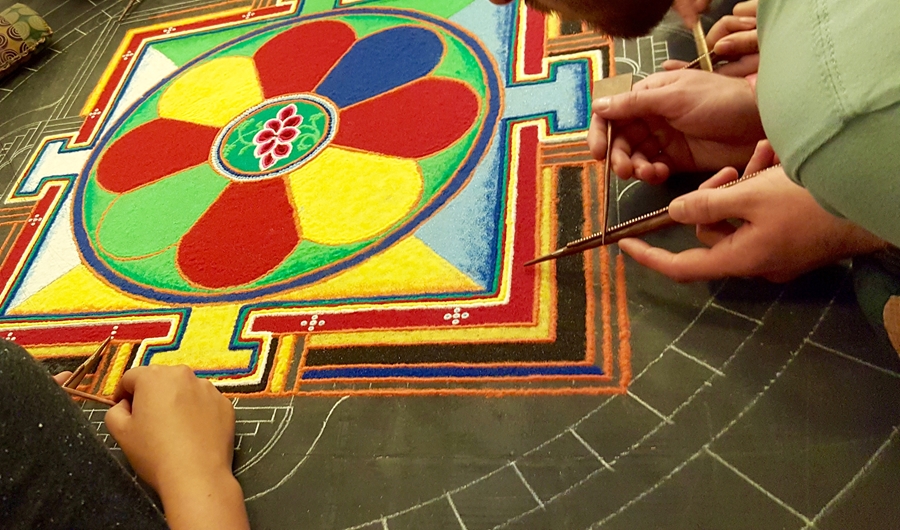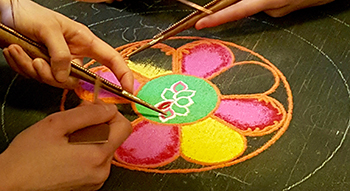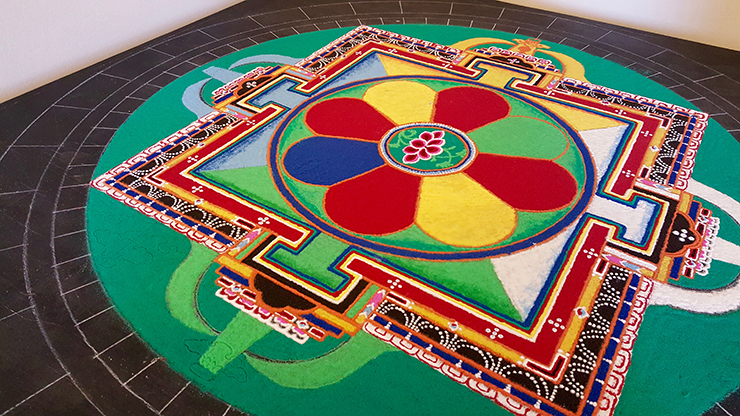Tibetan Studies Students Create, Then Prepare to Destroy Intricate Sand Mandalas

The mandala design for this semester's Tibetan Culture and Philosophy course taught by Geshe Thupten Dorjee centers around compassion as its core theme.
Students gather around two tables in the front of the classroom, taking turns adding brightly colored sand to the chalked outlines of mandalas, or intricate geometric designs, that are meant to represent our universe.
A soft, rhythmic scraping noise fills the room but it is not unpleasant. This is the sound of the chak-pur, a conical metal funnel with ridged sides. By moving a metal stick down the side of the chak-pur, the students can carefully control the distribution and placement of the sands they work with.
The room is intense with concentration, but it is also mellow and the occasional buzz of conversation joins the chak-pur to create a pleasing hum of activity.
"I've never had a class like this," said biology senior Jose Soroeta, who is also minoring in philosophy at the university's J. William Fulbright College of Arts and Sciences. "It's completely different and more interaction-based. I feel like we're jumping right into the Tibetan culture with a truly first-hand experience."
Soroeta wasn't sure what to expect when signing up for Geshe Thupten Dorjee's Tibetan Culture and Philosophy course, but the native Argentine by way of Fort Smith knew he wanted to learn more about the Buddhist religion.
 Students use chak-purs to add colored grains of sand during the first step of creating a mandala. |
Making the sand mandalas, said Dorjee, gives students like Soroeta the experience of "creating something beautiful and then destroying it to learn how to let go."
"We cannot hold onto something forever, something we attach to cannot last forever," said Dorjee, who spent much of his early life in a refugee camp in Bhutan with other Tibetan exiles before settling in Southern India. He then entered the Drepung Loseling Monestary in Karnataka when he was 13.
Dorjee later received the degree of lharampa geshe, the highest academic degree possible within the Gelug monastic university system, after mastering the five subject areas of Perfection of Wisdom, Middle View, Valid Cognition, Discipline and Metaphysics. After many travels and time spent teaching, in 2006 Dorjee was offered a one-semester appointment within Fulbright College that blossomed into much more - including being awarded the University of Arkansas Outstanding Faculty Award in 2008.
Now, Dorjee continues to teach the Tibetan culture course as well as others and is also co-director along with Professor Sidney Burris of the university's Tibetans in Exile (TEXT) Program.
While gesturing to the larger of two sand mandalas the class is working on, Dorjee explains that the colors and lines of each design also hold significance. More than 24 colors are used, with white, yellow, red, green and blue making up the fundamental core. The mandala designs for this semester's course include a larger one with a circle surrounded by petals, inside a box with intricate designs in vivid yellows, reds, greens and blues predominantly. This one centers around compassion as its main theme.
A second, smaller practice mandala today features a lotus center with green, yellow and pink petals inside concentric circles. It typically takes the students between four-to-six classes to complete the large mandalas, though they practiced in the weeks leading up to the project.
"The students determine how much sand and how much control with each movement," Dorjee said. "They practice a lot first, and it also depends on if they are stressed or not stressed."
Some students use small pillows to rest their forearms and aid in their precise sand placement. All of the 14 participants wear similar looks of focused, yet still relaxed concentration. Some take breaks, switch out colors, or ask for guidance on the next step when they've completed a task. Others switch back and forth, working a little on each mandala.
Soroeta stops and stretches. He was surprised to learn the mandalas would be destroyed after completion. "I thought, 'Oh no! What can we do to preserve them?'" he said. "But then in the end I understand the philosophy."
Likewise, his classmate Emily Miller, a senior majoring in chemistry with a focus in biochemistry, said letting go of the artwork will be sad.
"I did know going into the class we'd be doing this. We'll be taking lots of pictures," she joked. "You really have to focus with the sand, and don't realize it takes this much effort. You do get attached to the mandalas."
For Miller, what struck her the most about Tibetan culture is the emphasis on love and compassion. She said she was also amazed at how welcoming and open Dorjee has been, even preparing a meal for his students.
Miller will be attending University of Arkansas for Medical Sciences (UAMS) in Little Rock after graduation, and she was surprised to learn how many students in the class would be pursuing a similar career path.
"A lot of us in class are going to medical school, at least five of us," said Miller, who said she thinks what the students have learned from Dorjee, in the class, and from their sand mandala experience will serve them well as future medical practitioners.
"The principles from this class are great and will stay with you," she said. "Do everything with love and compassion, live out your entire life that way and always have a giving mentality."

About the J. William Fulbright College of Arts and Sciences: The J. William Fulbright College of Arts and Sciences is the largest and most academically diverse unit on campus with 19 departments and 43 academic programs and research centers. The college provides the core curriculum for all University of Arkansas students and is named for J. William Fulbright, former university president and longtime U.S. senator.
Contacts
Thupten Dorjee, instructor, Humanities
J. William Fulbright College of Arts and Sciences
479-575-4801,
tdorjee@uark.edu
Andra Parrish Liwag, director of communications
J. William Fulbright College of Arts and Sciences
479-575-4393,
liwag@uark.edu
Headlines
Four Students Named Goldwater Scholars; Two Earn Udall Honorable Mentions
Four U of A students have received the prestigious Goldwater Scholarship, an award for top students in mathematics, science, and engineering.
Cross-Campus Collaboration Culminates in New Outdoor Geological Installation
Grand opening event to celebrate the new GeoLab installation at the U of A’s Gearhart Hall courtyard is set for May 3. The installation will be open to the public year-round.
First Students to Use Online Degree to Hone Nursing Leadership, Elevate Patient Care
Hanna Baxendale and Wendi Kimbrell will begin coursework in the Doctor of Nursing Practice-Executive Master of Business Administration program offered by the Eleanor Mann School of Nursing and Walton College.
Join the Office for Sustainability on a Final Cruise to Campus
Cruise to Campus Wednesdays have fostered a gathering space for individuals interested in biking to campus. Drop by the Old Main Lawn from 7:30-10 a.m. Wednesday for coffee, something to eat and conversation.
Fay Jones School Student Ambassador Program Gives Voice to Design Students
The student ambassador program at the Fay Jones School of Architecture and Design is built to connect top design students with their school, its alumni, its future students and others inside and outside the school.




